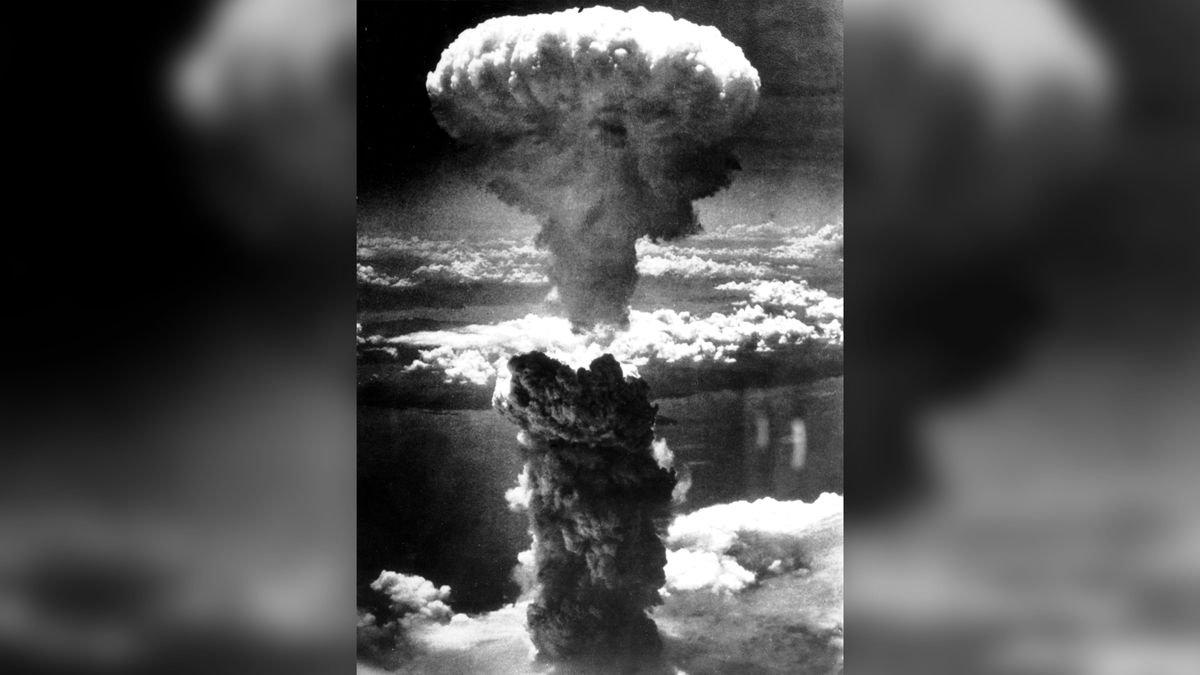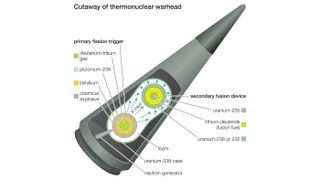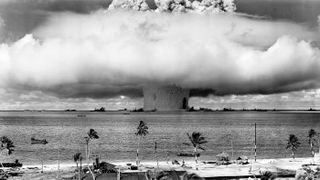What happens when a nuclear bomb explodes?
Here's what to expect when you're expecting Armageddon.

Christopher Nolan's movie Oppenheimer, released during Russia's continuing war with Ukraine, has renewed public interest in atomic weapons just as the risk of a nuclear conflict heightens.
But what would a nuclear bomb blast look like for those on the ground, and what would happen in the aftermath?
The answer depends, of course, on how many weapons are dropped. Russia and the United States have 90% of the world's nuclear weapons, according to the Federation of American Scientists. Russia has 1,588 weapons deployed on intercontinental missiles, which have a range of at least 3,417 miles (5,500 kilometers) and heavy bomber bases, which host aircraft capable of carrying and dropping a nuclear payload, and the U.S. has 1,644 weapons poised in the same way. (The two countries also have another nearly 5,000 active bombs between them that are functional and simply awaiting launchers.) A full-scale nuclear war could easily represent an extinction event for humanity — not just because of the initial deaths but also because of the global cooling, so-called nuclear winter, that would follow.
Perhaps a more likely scenario, according to some foreign policy experts, involves a limited-scale nuclear conflict using so-called tactical atomic weapons. According to the James Martin Center for Nonproliferation Studies, 30% to 40% of the U.S. and Russian arsenals are made up of these smaller bombs, which have ranges of less than 310 miles (500 kilometers) by land and less than 372 miles (600 km) by sea or air. These weapons would still have devastating impacts near the blast zone, but would not create the worst-case global nuclear apocalypse.
When a nuclear bomb explodes

There are different types and sizes of nuclear weapons, but modern bombs start by triggering a fission reaction. Fission is the splitting of the nuclei of heavy atoms into lighter atoms — a process that releases neutrons. These neutrons, in turn, can careen into the nuclei of nearby atoms, splitting them and setting off an out-of-control chain reaction.
The resulting fission explosion is devastating: It was fission bombs, sometimes known as atomic bombs or A-bombs, that destroyed Hiroshima and Nagasaki, Japan, with the force of between 15 kilotons and 20 kilotons of TNT. Many modern weapons, though, have the potential to do even worse damage. Thermonuclear, or hydrogen, bombs use the power of the initial fission reaction to fuse hydrogen atoms within the weapon. This fusion reaction kicks off yet more neutrons, which create more fission, which create more fusion, and on and on. The result, according to the Union of Concerned Scientists, is a fireball with temperatures that match the heat of the center of the sun. Thermonuclear bombs have been tested, but never used in combat.
Needless to say, being at ground zero of such an explosion means instant death. For instance, a 10-kiloton nuclear weapon, equivalent to the size of the Hiroshima and Nagasaki bombs, would immediately kill about 50%t of the people within a 2-mile (3.2 km) radius of ground detonation, according to a 2007 report from a Preventive Defense Project workshop. (An air detonation would have a wider blast radius, according to the nonproliferation organization ICAN.) Those deaths would be caused by fires, intense radiation exposure and other fatal injuries. Some of these people would be injured by pressure from the explosion, while most would be exposed to injuries from collapsed buildings or from flying shrapnel; most buildings in a 0.5-mile (0.8 km) radius of the detonation would be knocked down or heavily damaged.
Sign up for the Live Science daily newsletter now
Get the world’s most fascinating discoveries delivered straight to your inbox.
The U.S. government website Ready.gov advises that anyone with prior warning — either from official communications or from seeing a flash from a nearby detonation — move to a basement or the center of a large building and stay there for at least 24 hours to avoid the worst radioactive fallout.
There would be little help for survivors near the detonation area, however, according to the International Committee of the Red Cross (ICRC). With roads and train tracks destroyed, hospitals leveled, and doctors, nurses and first responders in the blast zone dead or injured, there would be few options for bringing in supplies or people to help, especially given the high levels of radiation following a detonation. Survivors would carry radioactive dust and would need to be decontaminated. Most would likely suffer thermal burns from the initial thermal blast, according to the book "Nuclear Choices for the Twenty-First Century: A Citizen's Guide" (MIT Press, 2021). Death could also come by firestorm, the book says; depending on the terrain of the blast zone, fires caused by the initial blast can combine and create their own, self-fueling wind. Such a firestorm occurred in Hiroshima, according to the U.S. Department of Energy, engulfing 4.4 square miles (11.4 square kilometers).
Radioactive fallout

Radiation is the secondary, and much more insidious, consequence of a nuclear blast. The fission bombs dropped on Japan created local fallout, according to "Nuclear Choices for the Twenty-First Century," but modern thermonuclear weapons blast radioactive material high into the stratosphere (the middle layer of Earth's atmosphere), allowing for global fallout. The level of fallout depends on whether the bomb is detonated above the ground in an air blast, which worsens global fallout but dampens the immediate effect at ground zero, or on the ground, which limits the global impact but is devastating for the immediate area.
The fallout risk is most severe in the 48 hours after the blast. In the absence of snow or rain — which would help to pull the fallout to the ground faster — far-flung particles may have minimal radioactivity by the time they float to Earth, according to the handbook "Nuclear War Survival Skills" (Oak Ridge National Laboratory, 1987).
By 48 hours after the blast, an area that is initially exposed to 1,000 roentgens (a unit of ionizing radiation) per hour will experience only 10 roentgens per hour of radiation, according to "Nuclear War Survival Skills." About half of the people who experience a total radiation dose of about 350 roentgens over a couple of days are likely to die from acute radiation poisoning, according to the handbook. (For comparison, a typical abdominal CT scan may expose people to less than 1 roentgen.)
Survivors exposed to fallout are at high risk of cancer throughout the rest of their lives. According to the ICRC, specialized hospitals in Hiroshima and Nagasaki have treated more than 10,000 officially recognized survivors of the 1945 blasts, with most deaths in this group attributable to cancers. Leukemia rates in radiation-exposed victims were four to five times typical levels in the first 10 to 15 years after the blast, according to the Red Cross.
Environmental catastrophe
Radioactivity and fallout would have serious environmental and health effects. Depending on the size of a nuclear conflict, the blasts could even affect the climate.
In a place like Ukraine, which produces 10% of the world's wheat, fallout might land on croplands. If fallout is taken up by the food supply, it could cause longer-term problems, such as cancer, Michael May, co-director emeritus at Stanford University's Center for International Security and Cooperation and a director emeritus of the Lawrence Livermore National Laboratory, told Live Science in 2017. Radioactive iodine, in particular, could be a problem, he said.
"Cows are concentrating the iodine in the milk, and children concentrate the iodine in the milk into the thyroids," leading to thyroid cancer, May said.
The ash and soot injected into the atmosphere during a nuclear war could have a serious cooling effect on the climate if enough bombs were dropped. While one or two nuclear explosions would not have global effects, the detonation of just 100 weapons the size of the one dropped on Hiroshima in 1945 would lower global temperatures to below those of the Little Ice Age that occurred from roughly 1300 to 1850, according to a 2012 analysis published in The Bulletin of the Atomic Scientists. The impact today would be a wild and sudden climate swing: Temperatures during the Little Ice Age fell by as much as 3.6 degrees Fahrenheit (2 degrees Celsius), a bigger drop than the increase in warming seen since the beginning of the industrial revolution (approximately 1.8 degrees F, or 1 degree C). A sudden chill like that today could impact agriculture and the food supply. The Little Ice Age caused crop failures and famine at a time when the global population was less than one-seventh of what it is today.
To maximize your chances of surviving a nuclear attack, Ready.gov recommends keeping an emergency supply kit on hand in a safe shelter location. (The same kit can also be used during other disasters, such as hurricanes or long-term power outages.)
Originally published on Live Science.

Stephanie Pappas is a contributing writer for Live Science, covering topics ranging from geoscience to archaeology to the human brain and behavior. She was previously a senior writer for Live Science but is now a freelancer based in Denver, Colorado, and regularly contributes to Scientific American and The Monitor, the monthly magazine of the American Psychological Association. Stephanie received a bachelor's degree in psychology from the University of South Carolina and a graduate certificate in science communication from the University of California, Santa Cruz.
- Ben TurnerSenior Staff Writer
- Tia GhoseManaging Editor










